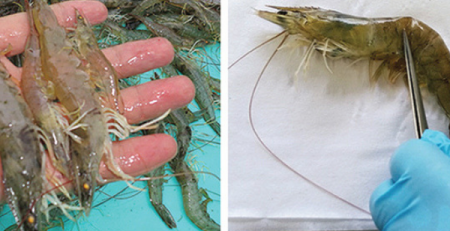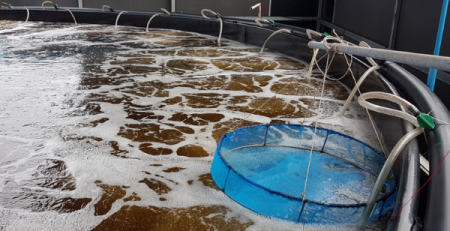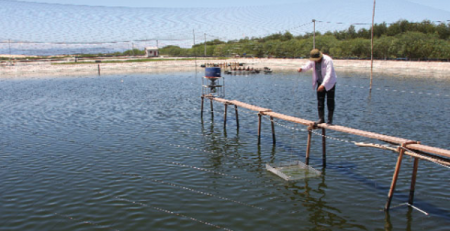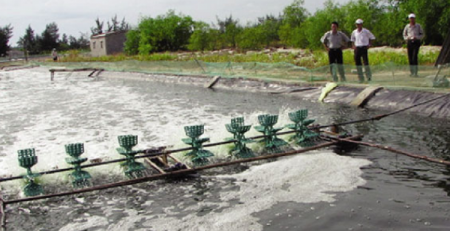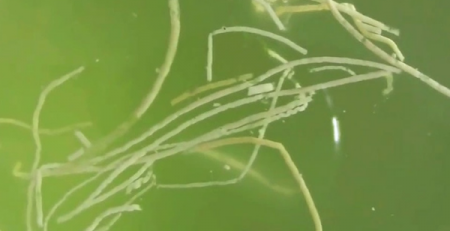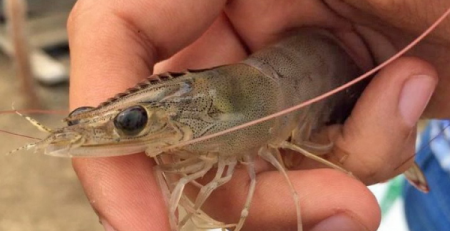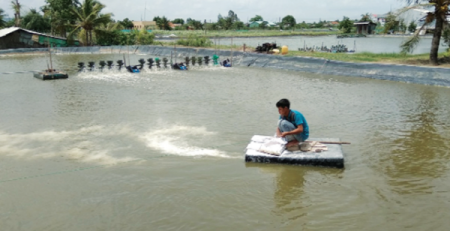Effective pond bottom management
Good shrimp pond bottom treatment will help reduce the damage during the culture process, and at the same time help shrimp grow healthy, not from diseases from the water environment, resulting in a successful shrimp crop.
Việc xử lý đáy ao nuôi tôm tốt sẽ giúp giảm được những thiệt hại trong quá trình nuôi, và đồng thời giúp tôm sinh trưởng khỏe mạnh, không bị các bệnh từ môi trường nước, đem lại một vụ tôm thắng lợi.

Periodically use biological products to decompose organic substances
Before raising
Draining pond water and settling ponds. Removal of pests in the pond from previous crop (shrimp, crab, snail, insect, trash fish). Dredging pond bottom, remodeling banks, water supply and drainage culverts. The bottom of the pond slopes towards the drain. The pond should be compacted to prevent erosion and leakage. Raise ponds around the pond to avoid external host species such as crab, cunt, snake.
Plow and dry bottom for at least 10 consecutive days or until soil cracking. Pond bottoming is one of the most important and indispensable steps in pond culture techniques. This will help to oxidize the organic matter, reduce the concentration of H2S gas and especially people can take advantage of the sun’s ultraviolet ray to kill the bacteria and pathogens harmful.
Liming the lime (lime cool) depending on the pH of the ponds that use the appropriate amount. Raise the lime thoroughly to the bottom to kill all shrimp, crabs, shackles, insects, trash fish remains, disinfection in the mud, detoxification (heavy metals, H2S) and neutral pH.
Use of biocides such as Chlorine, BKC, violet … around the pond to completely eliminate the bacteria cause. Subsequently, microbial culture to stabilize water color and create favorable conditions for microorganisms to develop. Should check the pH, alkalinity, salinity … before stocking.
Water supply system for ponds: The paddle system for the ponds is critical to the oxygen content of shrimps, and at the same time they help collect waste and organic residues at an angle. Therefore, the farmer should be equipped with a fan system to ensure sufficient oxygen diffusion for shrimp.
In addition, for ponds, ponds are compacted carefully, before the canvas should be flat bottom pond bottom, leaning toward the sewer, pond bottom should be dried. It is possible to use HDPE or tarpaulin, the panels are sealed together, spread over the entire bottom and pond floor. When spreading canvas against the bottom, it is necessary to install 3 – 4 air ducts connected from below the bottom to the shore, avoiding the accumulation of gas underneath, pushing canvas inflated when bringing water into the pond. If you have spread the shrimp from the previous crop, drain the water, using high pressure spray pump to clean the dirt on the canvas, then use chlorine water to fall on the canvas surface, exposed after 5 – 7 days before Get water into the pond.
During the farming process
During the crop, organic wastes such as shrimp faeces, leftover food, peeled shrimp peels, etc. increase over time, which is the cause of nutrient deficiency in ponds. Toxic (green algae, algae, …) develops superiority. In addition, organic decomposition produces toxic gases such as NH3, H2S, NO2 … causing shrimp disease or causing shrimp to die scattered or even die if not handled in time.
The characteristics of the shrimp are to live and look for food at the bottom, so when the amount of sludge in the ponds will make shrimp more susceptible to many diseases such as bearing necrosis, black gills, yellow gums … Thus, From the 2nd breeding month onwards, the amount of sludge in the pond will start to increase due to the increase in feed volume. At the same time, the management of solid waste is good management of feed and water quality.
In addition, it is necessary to enhance the operation of water fans and aeration systems to minimize the impact of bottom sediment and also to add biological products in aquaculture to decompose organic matter and gases. toxic in ponds.
After stocking shrimp 10 days should use biological products clean water pond every 5 – 7 days.
After 1 month of farming, carry out periodic siphon once every 4 days; When the bottom should be soft, adjust the valve just enough, avoid shrimp being siphoned out in the siphon tube.
Choose high quality foods and use food reasonably to avoid overproduction. Poor feed quality leads to high feed conversion ratios; The disintegration of food in large water causes shrimp to not use all food; This will increase the amount of sludge in shrimp farming.
Cre: contom.vn


